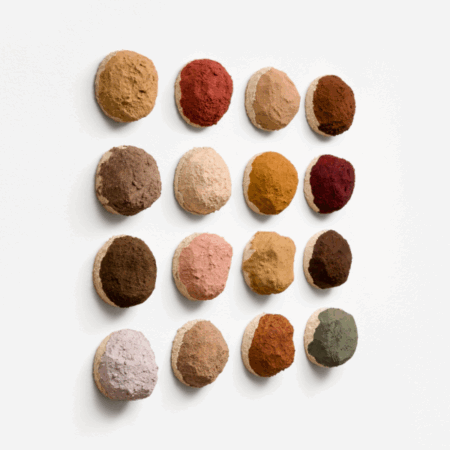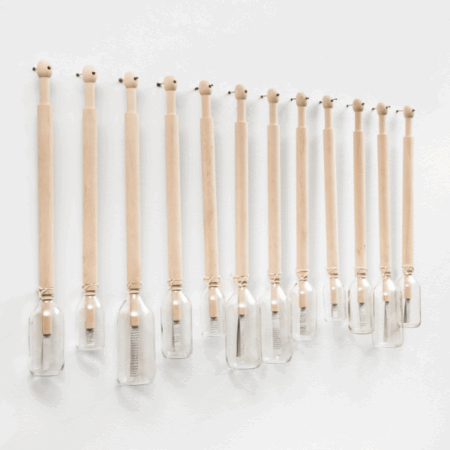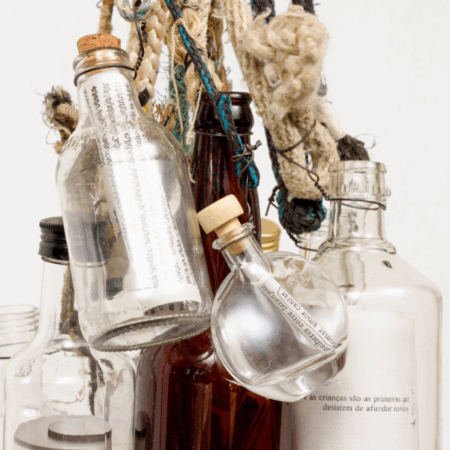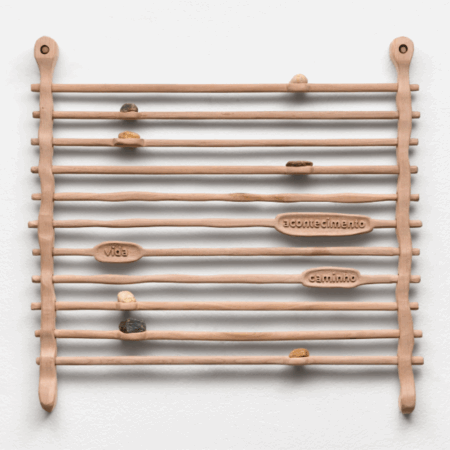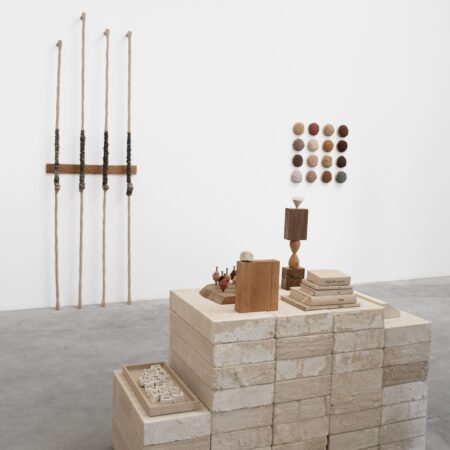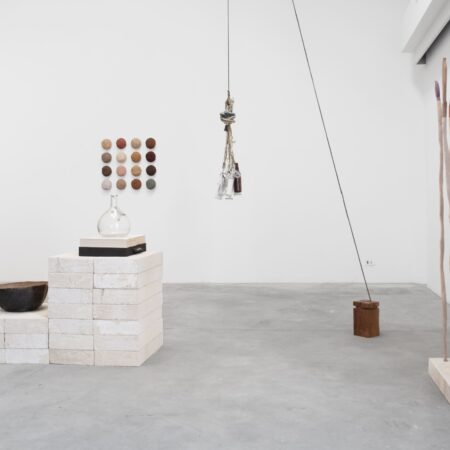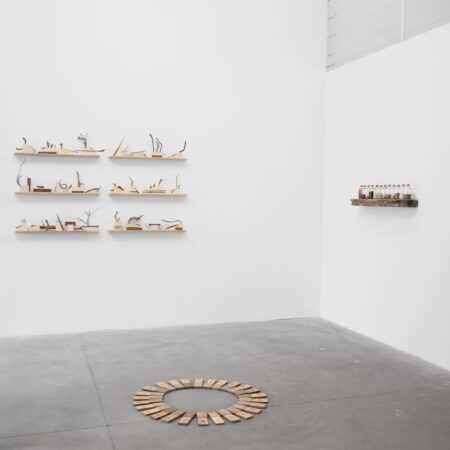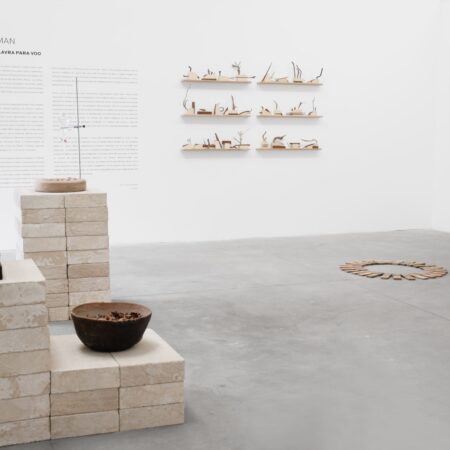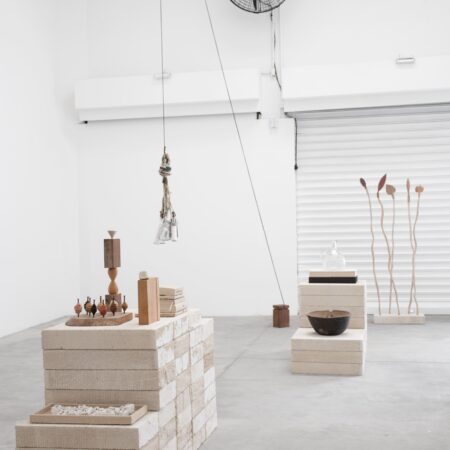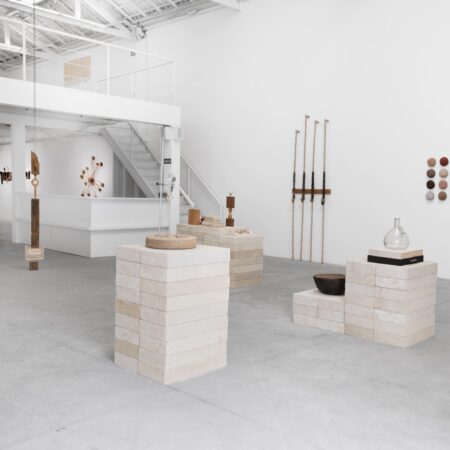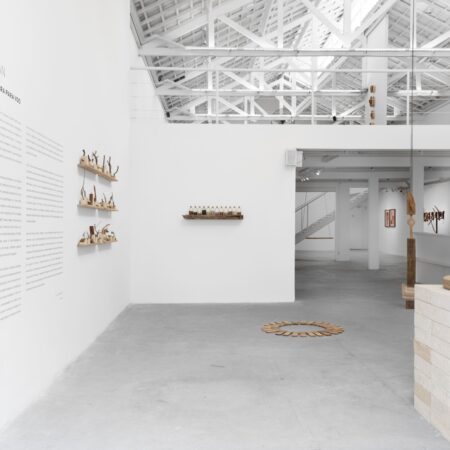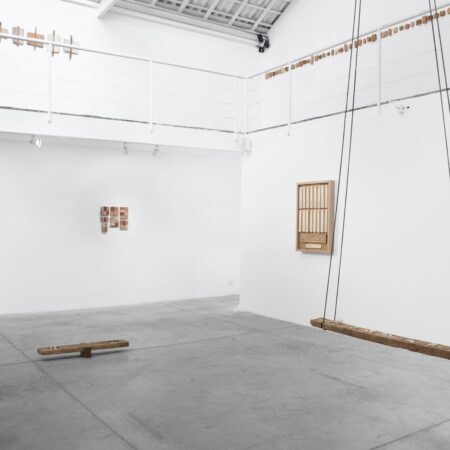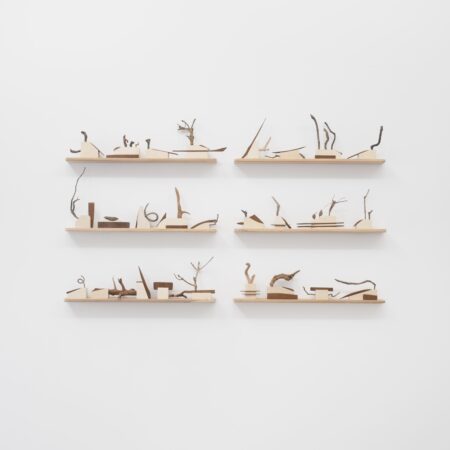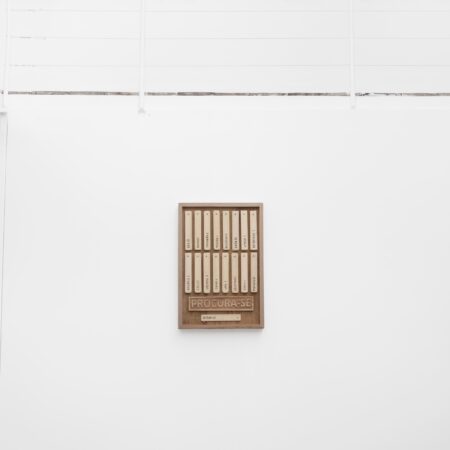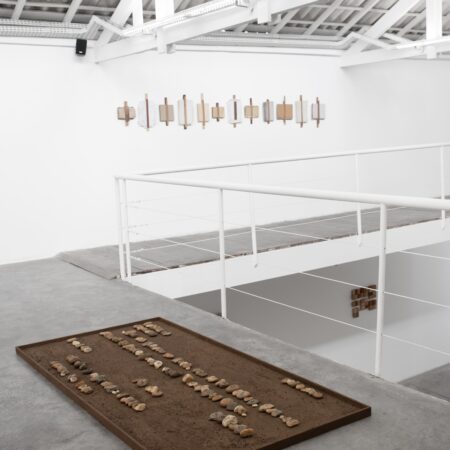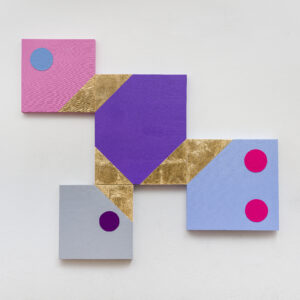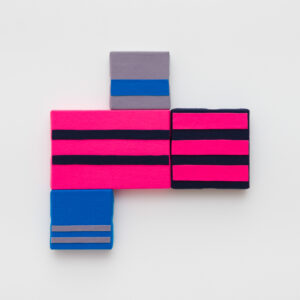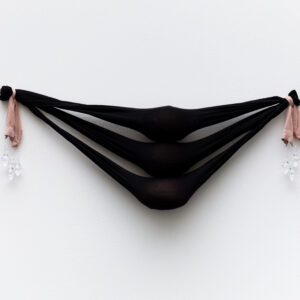
02 de agosto 2025 a
24 de setembro 2025
Luis Maluf Galeria
Rua Brig. Galvão, 996
Barra Funda, São Paulo, SP
Chão é outra palavra para voo
Deco Adjiman
“Voltar ao chão, ao peso do corpo, é voltar a si mesmo. Quando os pés tocam o solo, instauramos uma nova relação com o mundo: deixamos de pairar sobre a realidade e passamos a habitá-la. Ao caminhar, o corpo se torna medida do tempo e do espaço. Os pensamentos deslizam, circulam. O espírito não se fixa, ele, enfim, flutua – ou melhor, voa. Nessa travessia tudo transmuta: chão torna-se paisagem; horizonte, pauta; pensamento, palavra. É sobre esse exercício de coleta e deslocamento, seja do espaço ou da escrita, criando a partir disso distintas fabulações, que se estrutura a produção artística de Deco Adjiman.
Transformar o ordinário em sagrado é um dos compromissos de Adjiman com a matéria natural que reúne, assim como com a arte. Pedras, pedaços de troncos e galhos, folhas, terra e outros insumos que nos proporcionam a experiência ambiental do viver na Terra expandem-se no espaço e buscam novos significados em suas mãos. Tornam-se ferramenta, cor, textura e memória para ritualizar o entre, esse espaço que compreende toda a existência – “a coisa não está nem na partida nem na chegada, está na travessia”, já diria Guimarães Rosa (1908-1967). Neste trajeto muitas são as descobertas e encontros, e na obra de Adjiman não é diferente. Dentre elas, a cor alcançada ao moer a terra bruta no pilão, coletada em diferentes estados do Brasil, destaca-se como elemento-chave de seu processo atual. A transitoriedade do território no espaço/tempo acaba ganhando corpo em ideias e debates, gerando composições em que a materialidade da paisagem se converte em linguagem.
A palavra que pontua esta que é a primeira individual do artista na Galeria Luis Maluf, em São Paulo, é antiga companheira de caminhadas do artista. A paixão pela literatura e a troca profunda com o espectador alimentam sua produção, como é possível ver em “Dose de doze”, instalação inédita inserida no primeiro salão da galeria, composta por garrafas, madeira, papel e cordas diversas, entre elas muitas coletadas no mar e em portos atravessados pelo artista. As doses literárias, encapsuladas nos vidros, e que poderiam ter viajado pelos mares como mensagens a serem entregues a alguém em algum lugar distante, são trechos e resumos feitos e escolhidos por Adjiman de doze livros enviados por conhecidos que, como ele, nutrem uma próxima relação com a escrita. O alfabeto e o gesto que nos é tão recorrente do lápis no papel surgem em diversos trabalhos ao longo do espaço, mesmo na ausência concreta da palavra – como se pudéssemos ler as histórias inscritas nas matérias-primas naturais com as quais as peças foram criadas.
Entre outras tantas produções preparadas especialmente para esta mostra está “Ascensão”, escultura recém-produzida em uma residência feita por Adjiman no Parque Nacional do Itatiaia, divisa entre os estados do Rio de Janeiro e Minas Gerais, na Serra da Mantiqueira. A obra é como uma paisagem desconstruída. Traz em si cordas tingidas cada qual pela terra de uma das quatro montanhas escaladas pelo artista na região. Os longos fios de algodão possuem as medidas das circunferências dos cumes, como em um abraço laçado. Os troncos, de alturas que fazem referência às das próprias montanhas, apoiam-se na paisagem entalhada na madeira, que recria a linha de elevações de tais formações rochosas, entre elas a do Pico das Agulhas Negras, o quinto mais alto do Brasil.
Além de local de coleta e destino, o topo das montanhas também é onde o chão encontra o céu e os tantos possíveis voos da mente. Nesse mundo que se desdobra abaixo de nossos olhos se apresenta um imenso organismo vivo no qual tudo está conectado. Foi tal epifania que teve o naturalista Alexander von Humboldt (1769-1859) ao escalar em 1802 a montanha de Chimborazo, nos Andes, até então tida como a mais alta do mundo. No retorno, Humboldt desenhou seu famoso “Naturgemälde”, que revolucionou o entendimento da natureza que temos até os dias de hoje, dando-nos a noção atual de Ecologia. É esse mesmo instigante e natural caminho que segue Deco Adjiman. Uma busca pela beleza do caminho e pela potência de quem está sempre em movimento a fim de conectar-se à terra.”
Ana Carolina Ralston
Curadora
Group Exhibition
16 de agosto de 2025 a
22 de outubro de 2025
Luis Maluf Galeria
Rua Peixoto Gomide, 1887
Jardins, São Paulo, SP
conceder às constelações que nos habitam o direito de sonhar em liberdade
ANA NEVES, AMANDA FAHUR, CAROLINE RICCA LEE, FLAVIA VENTURA, GUILHERME CALLEGARI, IAH’RA E JULIANA DOS SANTOS
There are several themes that take shape in the territory of the body. In 1947, Antonin Artaud presented his manifesto ‘To end God’s judgement’. In it, the playwright declared a metaphorical war on organs. In his preaching, what Artaud was really suggesting was the birth of a new body, one that was capable of fully experiencing life itself. In his words, organs represented functionality, purpose and meaning. A new body that is unable to perceive the boundaries between inside and outside. In this respect, what Artaud meant was that, in his view, a body without organs would be a body in full expansion.
Almost half a century later, Gilles Deleuze and Félix Guattari took up Artaud’s initial ideas in their book A Thousand Plateaus. In it, the authors argue that multiplicity is inherent to reality itself, explaining that the body is not just an organism, the body is, at the same time, a body without organs: without organs not in a concrete way, like a body without a heart or a brain, but in the sense of being unorganised. The body without organs are the multiplicities; the practices that disorganise the organism and the possible experimentations of a body that wants to exist in the world without a formal delimitation on standards imposed by a limiting society.
Reflecting on these other possibilities for thinking about the body is one of the pillars that guides this exhibition. While preserving the individuality of each work and artistic research, in common, the works gathered here by Ana Neves, Amanda Fahur, Caroline Ricca Lee, Flávia Ventura, Guilherme Callegari, iah’ra and Juliana dos Santos intend knowledge, ways of thinking and acting, since the discourses established by the artists affect and dispute the ways in which subjectivities are configured from a body in transformation.
Starting with the work of Guilherme Callegari, although his paintings are in dialogue with formalism, exploring issues of spatiality, light and geometry, there is a very strong subjective implication of the body. Firstly, because in this new phase of his pictorial research, the artist abandons large formats, bringing a dimension of intimacy to his paintings, causing his body to create a new relationship with artistic endeavour, so that this gesture causes a reflection in the viewer: instead of distance, we now experience proximity. In another, more subjective aspect, Callegari’s painting undergoes a transformation, as his body begins to experience other ways of feeling the world, in a more intuitive and spiritualised way, and this leads to a search for a kind of rational rupture, giving rise to thinking about representation in an abstract way.
In order to think about the work of Ana Neves, iah’ra and Juliana dos Santos, I would add to this discussion the thoughts of Denise Ferreira da Silva and her concept of Corpus Infinitum, in which the philosopher says that all existences – human, non-human and more than human – are ethically implicated, in other words, all things are interconnected. By moving between drawing, painting and literature, Ana Neves seeks, through hybrid bodies (human-fauna, human-flora, human-object), to highlight the sharing of the whole world that we are: perishable and migratory. By creating these fables about this body that dwells between the fields of figuration and abstraction, between territory and the search for belonging, the artist highlights the uncertainties inherent in this process of recognition, both internal and external.
In the case of iah’ra, the group of textile sculptures that are part of the exhibition are based on a physics phenomenon called solitons, or solitary waves, in which a wave propagates in a stable way without ever losing its original shape. This interaction between these soft bodies and space articulates an analogy between geometric elements and perception to connect the self and the world, demonstrating that this interaction is an infinite exchange, tensioning the notions of identity, individuality, collectivity and existence from a body that no longer wants to be read from a single idea about itself.
In my meeting with Juliana dos Santos, a question that the artist raised resonates to this day: what is the limit of the body? and this question has guided both my relationship with the works of the other artists taking part in the exhibition, as well as Juliana’s own set of works chosen for the show. Blue is the colour that Juliana dos Santos has dedicated herself to understanding. For years she has been creating paintings with the clitoria ternatea flower. Her works have taken on scales that involve us in such a way that the body begins to vibrate in other ways, expanding the concept of colour into fields such as: the social, the political, the imagetic, the textual and the sonorous. In the works presented here, the paintings take on another context that challenges the limits of the surface itself. In a very listening relationship with the compositions formed, Juliana breaks with this idea of the painting frame, thinking exactly about this limit of a body. By bringing new ways of thinking about a standard field, these hybrid figures that are created from this gesture make us think that a body is much more than lines and contours. Moulding oneself here is not about fitting in, but about expanding one’s own concepts about oneself.
If on the one hand Juliana is showing us processes of expansion from a subjective body, Amanda Fahur starts from the objectivity of her own body to expand concepts about it. When a body collapses, what are the ways of regenerating and strengthening it? These are some of the questions the artist tries to answer in some of her paintings. In a dreamlike, almost surreal way, Amanda points out ways to understand the mechanisms of a body that is affected daily by external factors and how these implications affect an entire established system. The answers to healing are multiple, but Amanda opts for a poetic path of reordering the fragments in search of a totality.
The body in a state of reorganisation are also concepts that permeate the research of Caroline Ricca Lee and Flávia Ventura. For Ricca Lee, the body assumes a place of memories, where the artist interweaves her existence with diasporic ancestral archives, creating fictions to compose existences that are created from payments, whether historical or generational. From decolonial and queer feminist perspectives, the assemblages created by Ricca Lee take on a character of overlapping, not only of languages, but precisely of these transits that constitute her existence, assuming that, above all, the body is also territory.
The notions of body-territory also permeate Flávia Ventura’s work. In her research, the artist investigates the body as a mutable device for sensitive experimentation. In her new series of encaustic works, as Flávia begins to experiment with new configurations for her own body, the painting gives up figuration to find in abstraction a space for non-response. In this way, the artist proposes a shift in the discourse on protagonism and power relations regarding gender, sexuality and aspects of identity.
In Walter Benjamin’s dialectic, ‘the image is the moment when what was joins what is in a flash, thus forming a constellation’. If for the philosopher image is a concept in suspension, in this exhibition the body emerges as a power from the various searches for freedom experienced by the artists, questioning – rather than answering – how these practices can enter the space of society.
Carollina Lauriano
curator
Exposição Individual
17 de maio 2025 a
23 de julho 2025
Luis Maluf Galeria
Rua Brig. Galvão, 996
Barra Funda, São Paulo, SP
Zanini de Zanine: forma e matéria
“Esta mostra nasce do desejo de escutar os materiais. Não apenas olhar para a forma que se inscreve sobre a matéria, mas acompanhar os gestos que a atravessam, as ausências que nela repousam, os mundos que se deixam entrever em suas texturas. Reunimos os trabalhos recentes de Zanini de Zanine que partem da cerâmica, da madeira, do metal e do papel não somente como suportes, mas como matéria sensível de inscrição, de memória e cosmologia.
A madeira e o barro, antes de qualquer manipulação, já são história e gesto. Vêm da terra, do ciclo das queimadas, trazem indícios da umidade e do calor. Em muitas cosmologias ameríndias e afro-brasileiras, essas matérias não são passivas: elas veem, ouvem, guardam. Para muitos povos, as formas geométricas evocam relações entre seres, forças, lugares e tempos. Cada linha é um elo; cada recorte, um limiar. As inscrições feitas sobre cerâmica ou madeira podem evocar mitos, delimitar corpos, traçar alianças.
As formas gravadas, pintadas ou recortadas nesses materiais — linhas, curvas, vazios, negativos — são aqui lidas nos trabalhos de Zanini para além da representação. São modos de presença, de memória e de evocação. Pela sua história pessoal e trajetória, em que o desenho e projeto sempre se fizeram presentes no design e na arquitetura, Zanini de Zanine explora a forma e a matéria para além das abstrações formais. Seus desenhos e recortes constroem uma cartografia afetiva e espiritual, uma espécie de escrita do invisível. Cada linha pode ser um caminho, uma evocação, uma memória. O que se inscreve é sempre mais que uma forma: é uma presença que pulsa sob a superfície da matéria.” — Priscyla Gomes
Feira Nacional
02 – 06 de abril de 2025
Booth G4
Bienal de S. Paulo – Ibirapuera
SP-ARTE 2025
A Luis Maluf Galeria apresenta na SP–Arte 2025 uma seleção de obras de artistas representados, convidados e participantes da 4ª edição do Programa de Residência. A curadoria reflete a diversidade das práticas contemporâneas, explorando a percepção sensorial, o gesto e a memória.
A seleção reúne diferentes abordagens e experimentações, proporcionando uma reflexão sobre a relação entre corpo, espaço e materialidade, ampliando o entendimento sobre as questões mais urgentes da arte atual.
–
[SP-Arte 2025]
Pavilhão da Bienal – Parque Ibirapuera
[Visitação – Stand G4]
02 de abril – convidados
03 e 04 de abril – 12h às 20h
05 de abril – 11h às 20h
06 de abril – 11h às 19h
Exposição Coletiva
27 de março de 2025 a
15 de maio de 2025
Luis Maluf Galeria
Rua Peixoto Gomide, 1887
Jardins, São Paulo, SP
PENDULAR
Edu Silva e Mônica Ventura
A Luis Maluf Galeria, em parceria com a Galeria Nara Roesler, apresenta a exposição coletiva de Mônica Ventura e Edu Silva, sob curadoria de Aline Ambrósio, na unidade Jardins. A mostra propõe um diálogo entre as pesquisas de ambos os artistas, aproximando investigações que tensionam espaço, estrutura e memória.
Na obra de Mônica Ventura, a arquitetura se manifesta como suporte e vestígio, carregando camadas de transformação e identidade. Suas construções plásticas dialogam com materiais e técnicas artesanais, ativando referências afro-ameríndias e processos construtivos que sustentam modos de existência e transmissão de conhecimento. Sua produção já foi apresentada em espaços como Inhotim, Pinacoteca de São Paulo e Instituto Moreira Salles.
Edu Silva parte da relação entre cor e organização espacial para construir composições que refletem sobre estruturação social e território. Seu trabalho investiga a fragmentação e o equilíbrio entre elementos, criando articulações visuais que tensionam a lógica do espaço pictórico e tridimensional. Sua trajetória inclui exposições no Museu de Arte Moderna (MAM), Instituto Inhotim e Museu Afro Brasil.
A exposição articula esse encontro entre materialidades e concepções de espaço, abrindo leituras sobre construção simbólica e seus desdobramentos na arte contemporânea.
Vivaz – Residência Artística 2025
12 – 22 de março de 2025
Luis Maluf Galeria
Rua Brigadeiro Galvão, 996
Barra Funda, São Paulo, SP
VIVAZ
Adjetivo
- Caracterizado pela ação, dado à ação; ativo, enérgico.
- Que vive ou pode viver muito tempo; vivedouro.
Acompanhar doze diferentes artistas por dois meses é estabelecer um encontro com as diversas possibilidades de vida que cada indivíduo apresenta como questão de pesquisa conceitual e prática.
Podemos falar sobre essas aproximações como envolvimentos de vidas, pois, nos espaços desta galeria, outrora ateliê, foram estabelecidos novos afetos, contatos, carinhos, conexões e, por consequência, novos arranjos de trabalho, cores e matéria.
Vivaz é o resultado primeiro e mais palpável dessa confluência. A arte é pretexto, meio pelo qual pessoas se conectam e se apresentam ao mundo. A pesquisa de cada uma das pessoas artistas aqui presentes se abre como um novo idioma, com vocabulário e gramática próprios, mas que permitem traduções e significados comuns.
Que o vigor dessa produção sensível reverbere para além dessa experiência.
— Lorraine Mendes
–
[residentes]
Alexandre Heberte
Amorí
Ana Paula Sirino
Eduardo Baltazar
Erick Peres
Fernanda Pompermayer
Guilherme Borsatto
Hortência Eduarda
Naomi Shida
Rebeca Miguel
Sheyla Ayo
Xica
[coordenação]
Lorraine Mendes
[juri]
Dalton Paula
Luis Maluf
Maguy Etlin
A PRIMEIRA DÉCADA – Élle de Bernardini
29 de março a
07 de maio de 2025
Galeria Luis Maluf
Rua Brigadeiro Galvão, 996
Barra Funda, São Paulo, SP
A Luis Maluf Galeria apresenta “A PRIMEIRA DÉCADA”, exposição que marca os dez anos de trajetória de Élle de Bernardini, uma das artistas mais provocativas e essenciais da arte contemporânea brasileira.
Com curadoria de Ana Carolina Ralston, a mostra percorre diferentes fases de sua produção, reunindo obras que expandem os limites da pintura, escultura e instalação. O conceito contrassexual, central em sua pesquisa, atravessa as composições têxteis, as esculturas em materiais sintéticos e as performances registradas em vídeo.
Entre os destaques, a obra “Monalisa” ocupa o papel de peça-chave da exposição, sintetizando a força simbólica da produção de Élle. A seleção equilibra trabalhos icônicos e inéditos, construindo um panorama preciso de sua investigação sobre corpo, identidade e estética.
Com uma presença consolidada em coleções institucionais e privadas, Élle de Bernardini reafirma, nesta exposição, a potência e o valor de uma obra que desafia categorias e amplia discursos.
International Art Fair
February 05 to 09, 2025
Citibanamex, Mexico City | Booth A108
ZonaMACO 2025
Booth A108
Luis Maluf Galeria returns to ZonaMACO with a selection highlighting contemporary Latin American production, bringing together works by Aline Moreno, Bu’ú Kennedy and Daniela Busarello. Between painting and marquetry, the artists explore identity, territory and the interconnection between nature and culture.
Aline Moreno investigates the landscape as a translation of experience, combining materials such as wood, paper and stone to create compositions that move between the organic and the geometric. Bu’ú Kennedy, a Ye’pamahsã (Tukano) artist, gives new meaning to marquetry, transforming sheets of wood into visual narratives that echo ancestral knowledge. Daniela Busarello, in her metaphysical and abstract approach, incorporates natural pigments, oil and beeswax, materializing the fusion between art and ecology.
Visit us at ZonaMACO 2025, from February 5 to 9, at Centro Citibanamex, Mexico City. Booth A108.
Solo Exhibition
January 29, 2025 to
March 06, 2025
Luis Maluf Galeria
Rua Peixoto Gomide, 1887
Jardins, São Paulo, SP
Natureza da Realidade
[Nature of Reality]
Tatiane Freitas
Everything is movement. Us, above all. This is the premise that permeates Tatiane Freitas’ new series, shown for the first time in the exhibition Natureza da realidade at the Luis Maluf gallery. In her works, movement is not limited to the idea of transformation or progress; it embraces the continuous restlessness that runs through the artist and is reflected in her practice.
Tatiane Freitas is not only a creator, but also a spectator of what she produces, in a relationship in which the gaze, which is on the side of the work, as Lacan demarcates, constantly questions the artist. Thus, even when her work is considered finished, it doesn’t end. They reverberate, generate questions and open up avenues for other formulations.
This relationship with the gaze that emanates from the work resonates with the artist’s reflections, recorded in notes. Describing her experience in these series as an act of “getting out of fitting in”, she abandons the comfort of what is most familiar to her, launching herself into new territories. In an intimate reflection, also recorded in her notes, she mentions the idea of “losing one’s home” – echoing Freud, who points out the fragility of the “I” that is no longer “master of its own home”. This unveiling of identity vertigo permeates the works presented, inviting the public to share in the same atmosphere, as the identity of the materiality of the works is also subverted.
An offshoot of previous works and concerns, the works on display here have the same origin: chance. Continuing his research, centered on the construction of objects from the ruin of so many others, referring to everyday life and the home, new interlocutions are opening up. Old wooden doors, now mirrored in drawings, suddenly provided the first exploratory images for these new series, in a contingency that captured Tatiane. In this way, shapes emerged that were reminiscent of the old klecksographs, the art of creating images from stains, also popularized in the 19th century as a children’s game and later taken up by the famous Rorschach test.
But if these doors were at the origin of the works that make up this exhibition, their forms have only left their traces, new ruins produced by another time, that of the artist’s creation. They now remain as powerful openings, giving rise to something new, the work itself, and the different possibilities of readings and interactions with its viewers.
And in this same passage, the same opening, a dialog with nature is established. Different states of representation of wood appear in these series, in a parallelism with different states of being and reality.
Shapes take their place on natural fiber weft supports that are colored in India ink and charcoal; pieces of charcoal find their way into sculptures; an installation of small pieces of tracing paper houses acrylic paintings that have arisen accidentally from drops of paint and folds; images of furniture, parquet floors and trees, different times of the same materiality, emerge from the void dug in the structure of checkered wefts.
Being looked at by a work is something that we can share, that unites us in a collective, but that doesn’t make us all: we are one by one. It is in this way that the works to which we relate, in the here and now of this exhibition, cast us a gaze that crosses each one in a particular way, making each subject’s experience of the work unique.
Finally, a question that, although not new, never ceases to insist and find its resonance in Natureza da realidade: how does the artist manage, from her unique experience with language, to convey to us something of a reality that doesn’t close itself off, something so much her own, but which becomes so much ours and everyone’s, making us this collective that perhaps only art is capable of making exist?
Flavia Corpas
curator
Untitled Art, Miami Beach 2024
04 – 08 December 2024
1001 Ocean Drive
Miami Beach, FL
Untitled Art, Miami Beach 2024
Luis Maluf Galeria de Arte is pleased to announce its participation in Untitled Art Miami Beach 2024, which takes place from 4 to 8 December. For this edition of the fair, Luis Maluf is presenting the work of two contemporary artists, whose practices explore the relationship between art, spirituality and the natural world in different ways.
Shizue Sakamoto, a Japanese-Brazilian artist, fuses painting and the study of music, creating gradients of colour with a precision that recalls the fluidity of a musical composition. Her research is immersed in the search for tonal harmony, and in her works, the transitions between colours happen almost imperceptibly, without noise. This fluidity not only reflects an aesthetic quest, but also a reflection on the silence that permeates music, particularly the violin, an instrument close to his heart. Silence, in this context, is not the absence of sound, but an essential presence that allows the viewer to pass through a portal – as if the canvas were the entrance to a silent but profound sensory experience. The Belgian oil paint used by Sakamoto amplifies this transition, allowing the colours to blend with softness and elegance, inviting the viewer into a sense of serenity and balance, where contemplation becomes an intimate and sensory experience.
In her practice, Dutch artist Janet Vollebregt explores the relationship between architecture and Brazilian crystals, creating a reflection on how the form and energy of these elements can promote well-being. Her research proposes that the connection between the materiality of architecture and the energy of crystals not only reflects an aesthetic, but establishes a sensory experience that favours balance between body, mind and environment. By creating these experiences, Vollebregt opens up a field for introspection, where space is not limited to its physical form, but becomes a means for the transcendence of body and mind.
–
Untitled Art Miami Beach 2024
Booth: C35
Date: 4 to 8 December 2024
Address: 1001 Ocean Drive, Miami Beach, FL
